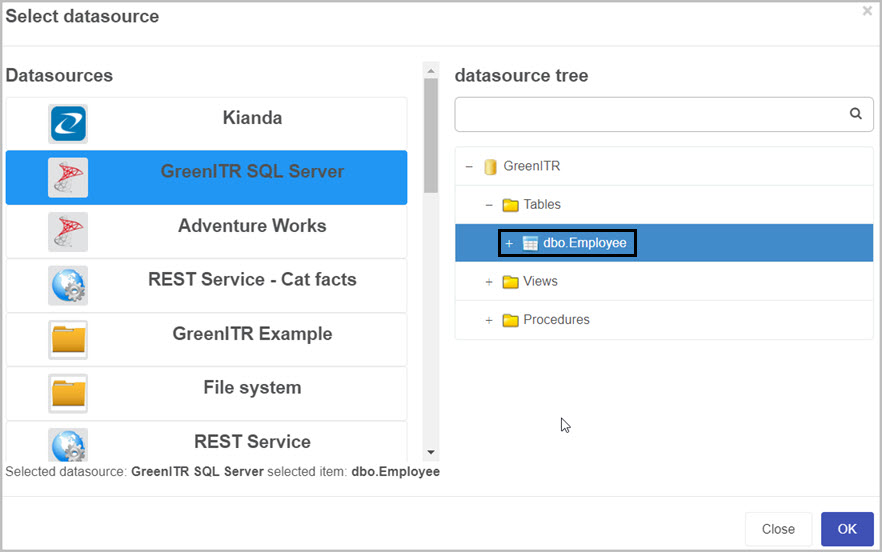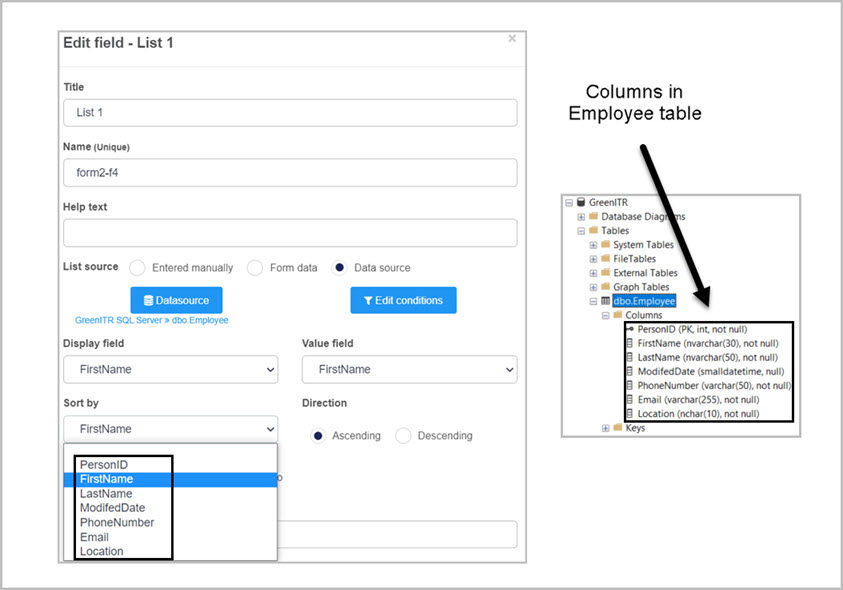SQL Server connector
One of the datasources available in Kianda is a Structured Query Language (SQL) Server datasource. Using the SQL server as your datasource, you can perform any Create, Read, Update and Delete (CRUD) operations using the Data rules provided in the Kianda platform, to learn more about data rules go to Data rules. Using the SQL server connector, you have access to all tables within your database from your server. Keep in mind that you can perform CRUD operations on data within a table of the database, but you cannot create or delete tables themselves.
When to use
You can use the SQL Server connector when you want access, modify or retrieve data within a table in your SQL server. When connecting a SQL server datasource to a List field, you can only connect and display information from a table, not the information of the server itself. For example if your SQL server contains tables such as Employees, Purchases and Standing Orders, you will be able to connect the list field to only one of those tables giving you CRUD access.
Before getting started
When establishing a connection using the SQL data connector, you are creating a connection with a Database from a server, not the server itself. Before continuing make sure that your SQL server has a database you can connect to.
In order to successfully establish this connection with your server, a user is needed to access the server by logging in. This user that you use to connect to the server must be a sysadmin.
How to get started
-
From the Kianda home page, click on Administration > Data sources.
-
Click on + Add new button
 and choose SQL Server from the list of datasources provided.
and choose SQL Server from the list of datasources provided. -
Fill out fields in the SQL Server details screen.

Choose from the edit options:
- Display name - type in a name for your SQL server connector. This is used to distinguish between different data connectors on your platform.
- Server - the name of the server you want to access or the IP address where the server is hosted. When you are running a local server on your machine you can use
localhostas the server name. - Database - the name of the database from your server that you want to connect to.
- Trusted connection - enable windows trusted connection. Only available when using with Kianda cloud connector, enabling this will automatically enable the Use Kianda Cloud Connect option. This option will use the connector service credentials to connect to the destination datasource. Having this option enabled will automatically hide the User and Password fields.
- User - username used to log into the server. Note that in order to log into a server with a username and password, the user must be a system admin for the connection to be successful.
- Password - password used to log into the server.
- Use Kianda Cloud Connect - by default this option is disabled, the cloud connect is used to create a connection between a locally run SQL server and Kianda itself. To learn more about Kianda Cloud Connect and how to create a connection between Kianda and your PC, go to Kianda Cloud Connect. Check this option if you want to connect to a server that is running on your local machine. When Use Kianda Cloud Connect is enabled, a Connectors option appears.
- Connectors - displays all available connector PC’s that have a connection established with your Kianda subscription. This option is used to select the PC connection that runs the local SQL server that you want to connect to.
-
When you have added the SQL server details, you are ready to test your connection and add security. At the bottom of the SQL Server details page, click on Test connection button
 and if the service has been correctly configured, then you should receive a notification saying Connection test succeeded.
and if the service has been correctly configured, then you should receive a notification saying Connection test succeeded. -
Click on Save
 to save the connection and you will receive a notification saying Details saved successfully.
to save the connection and you will receive a notification saying Details saved successfully. -
Add Security settings by clicking on the Security button, go to Setting security for data sources for more details.
-
Click on Close to close the details page and return to the data source management main view.
Connecting to a local server
Here we will go step by step on how to create a connection between your locally run SQL Server and your Kianda subscription. Follow the steps below to create this connection:

- Connect to a SQL server using
localhostas the name of the server. - Open the SQL details page by following steps 1 and 2 from How to get started.
- Choose a Display name.
- In the Server text box type in
localhost. - In the Database text box type in the name of your database you want to connect from your server. For this example we will connect to a GreenITR database from our server.
- Enable the Trusted connection checkbox.
- Enable the Use Kianda Cloud Connect checkbox.
- In the Connectors radio checklist, select the PC that you are running the local server on. For this example we are using PC31. To establish a connection between your Kianda subscription and your PC go to Kianda Cloud Connect.
- Click on Test connection.
- A notification Connection test succeeded shows up. Now you are ready to use the SQL connector that is run on your local machine.
SQL Server parameters
When you use a SQL Server datasource, unlike some of the other data connectors in Kianda, SQL Server does not have default parameters. When you connect a SQL server as your datasource, you can choose which table you want to use when performing CRUD operations. For example when connecting a SQL datasource to a List field and selecting a table you want to use, the parameters will depend on what columns are present in the table. Take GreenITR database from the Connecting to a local server example. We have an Employee table which we select when connecting a datasource to a List field, to learn how to a datasource to a list field go to List control, see image below:

The list of parameters displayed in the the Display field, Value field and Sort by field will match the columns that we have in the Employee table, see image below:

What’s next 
Your SQL Server connector is now set up and ready to be used in your processes. To find out more about how to design processes go to Designer.